Street Latin
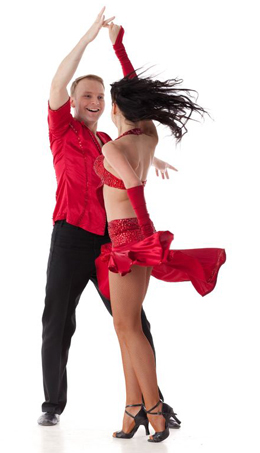 Salsa is a very spicy, exhilarating and energetic Street Latin dance. Loads of fun, complete with spins, sharp movement, and crisp turns. It incorporates many dips, drops and tricks making it a great dance to watch and of course – to dance! The salsa has become a popular world wide phenomenon and no doubt will continue to heat up the Latin Clubs for many years to come.
Salsa is a very spicy, exhilarating and energetic Street Latin dance. Loads of fun, complete with spins, sharp movement, and crisp turns. It incorporates many dips, drops and tricks making it a great dance to watch and of course – to dance! The salsa has become a popular world wide phenomenon and no doubt will continue to heat up the Latin Clubs for many years to come.
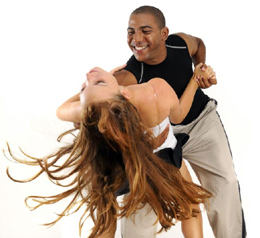 Merengue is a super hot, fast paced, high energy Street Latin dance. The music is upbeat and turbo charged – you can’t help but want to get up and Merengue. Merengue is a very simple dance style based on a ‘walking’ or ‘marching’ action. It can be danced with a partner or solo and is a good dance to use with as much or as little technique as you choose. The merengue, like salsa, is now recognised as a transnational phenomenon. If you go out to dance Salsa, the band will always play Merengue.
Merengue is a super hot, fast paced, high energy Street Latin dance. The music is upbeat and turbo charged – you can’t help but want to get up and Merengue. Merengue is a very simple dance style based on a ‘walking’ or ‘marching’ action. It can be danced with a partner or solo and is a good dance to use with as much or as little technique as you choose. The merengue, like salsa, is now recognised as a transnational phenomenon. If you go out to dance Salsa, the band will always play Merengue.
Latin
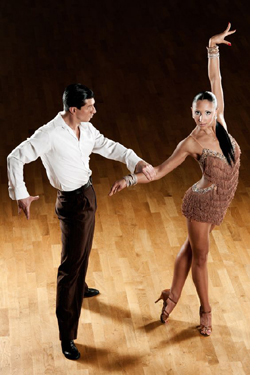 Cha Cha has an upbeat, infectious rhythm, which creates a sense of cheeky playfulness and flirtation. The cha cha is one of the most dominant “pop” rhythms of the last five decades making it a very versatile and usable dance. The cha cha is a dance of Cuban origin. The name of the dance is an onomatopoeia derived from the shuffling sound of the dancers’ feet.
Cha Cha has an upbeat, infectious rhythm, which creates a sense of cheeky playfulness and flirtation. The cha cha is one of the most dominant “pop” rhythms of the last five decades making it a very versatile and usable dance. The cha cha is a dance of Cuban origin. The name of the dance is an onomatopoeia derived from the shuffling sound of the dancers’ feet.
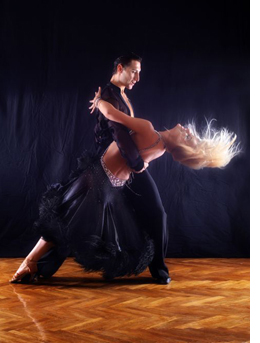 Rumba is a slow, passionate, romantic and sensuous Latin dance. In the US, the term ‘rumba’ began to be used during the 1920s to refer to ballroom music with Afro-Cuban music themes, particularly in the context of big band music. The first rumba competition took place in the Savoy Ballroom in 1930. By the end of the 20th century, rumba was also danced to pop music and jazz bands as seen in TV shows like Dancing with the Stars.
Rumba is a slow, passionate, romantic and sensuous Latin dance. In the US, the term ‘rumba’ began to be used during the 1920s to refer to ballroom music with Afro-Cuban music themes, particularly in the context of big band music. The first rumba competition took place in the Savoy Ballroom in 1930. By the end of the 20th century, rumba was also danced to pop music and jazz bands as seen in TV shows like Dancing with the Stars.
 Samba is a lively, exciting, sultry and rhythmical dance of Brazilian origin. It is known as a celebration dance in Brazil, with superb costumes and accessories. The Samba music rhythm has been danced in Brazil since its inception in the late 16th century.
Samba is a lively, exciting, sultry and rhythmical dance of Brazilian origin. It is known as a celebration dance in Brazil, with superb costumes and accessories. The Samba music rhythm has been danced in Brazil since its inception in the late 16th century.
Swing
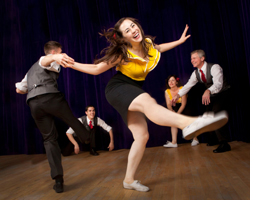 Swing (sometimes called “Jitterbug”) is a group of dances that developed with the swing style of jazz music in the 1920s-1940s. Swing styles include Lindy Hop, 6 step swing and Charleston. Swing dance is a super fun and high energy style of social dancing. It is quick, fast paced and at an advanced level is characterised by lots of swinging, flipping and throwing of dancers. Swing is a non-progressive dance style because it is mostly performed in one spot, making it a popular dance for a crowded dance floor. Swing dancing takes a little practice, but once you know the steps, you may never want to stop swinging.
Swing (sometimes called “Jitterbug”) is a group of dances that developed with the swing style of jazz music in the 1920s-1940s. Swing styles include Lindy Hop, 6 step swing and Charleston. Swing dance is a super fun and high energy style of social dancing. It is quick, fast paced and at an advanced level is characterised by lots of swinging, flipping and throwing of dancers. Swing is a non-progressive dance style because it is mostly performed in one spot, making it a popular dance for a crowded dance floor. Swing dancing takes a little practice, but once you know the steps, you may never want to stop swinging.
Jive and Rock’n’Roll
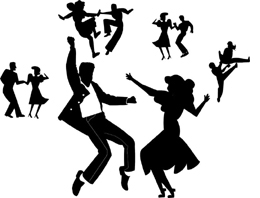 Jive is a very cheerful, boppy, energetic dance, with plenty of knee-lifting, bending, and rocking of the hips. One of the fastest social dances, Jive incorporates lots of kicks and flicks and even twirling of the woman. It is a lively and uninhibited variation of the Jitterbug, a form of Swing dance.
Jive is a very cheerful, boppy, energetic dance, with plenty of knee-lifting, bending, and rocking of the hips. One of the fastest social dances, Jive incorporates lots of kicks and flicks and even twirling of the woman. It is a lively and uninhibited variation of the Jitterbug, a form of Swing dance.
Rock ’n’ Roll, like jive is also a very happy, boppy energetic dance. A 1959 dance book describes “Rock ‘n’ Roll” as “performed without undue tension, the body and legs being flexible, so that there may be a physical rhythmic expression of co-ordination with the beats of music.” “…a dance which leaves much scope for personal expression and interpretation in style, movement, rhythm”.
Ball Room
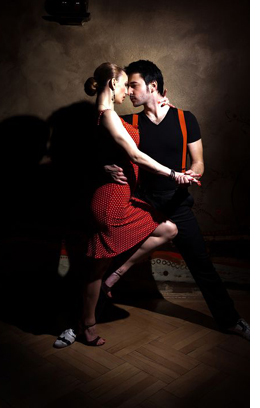 Tango is a dramatic, strong and striking dance. It has very rich potential for expression, improvisation and connection and is danced in both modern and traditional styles. It is often described as a passionate dance, because of the close connection partners can have, the character of the music, and also relating to some of the dance’s history. The dance originated in lower-class districts of Buenos Aires and Montevideo.
Tango is a dramatic, strong and striking dance. It has very rich potential for expression, improvisation and connection and is danced in both modern and traditional styles. It is often described as a passionate dance, because of the close connection partners can have, the character of the music, and also relating to some of the dance’s history. The dance originated in lower-class districts of Buenos Aires and Montevideo.
 Waltz is graceful, elegant and sophisticated. It is smooth progressive dance characterised by long, flowing movements, continuous turns, and rise & fall. Waltz dancers glide around the floor almost effortlessly. The tempo of 3/4 timing is generally slow but the expressive quality of the music often invites very powerful and dynamic movement from dancers.
Waltz is graceful, elegant and sophisticated. It is smooth progressive dance characterised by long, flowing movements, continuous turns, and rise & fall. Waltz dancers glide around the floor almost effortlessly. The tempo of 3/4 timing is generally slow but the expressive quality of the music often invites very powerful and dynamic movement from dancers.
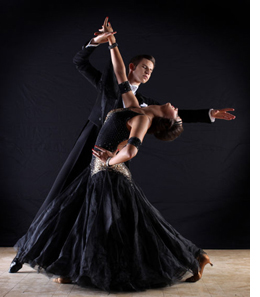 Foxtrot is a very stylish, smooth and progressive dance characterised by long, continuous flowing movements across the dance floor. The Foxtrot is a simple combination of walks and chases ideal for social dancing. At an advanced level Foxtrot brings the possibility of open, apart, and side by side movements. Foxtrot is very versatile and can be danced to 90% of music.
Foxtrot is a very stylish, smooth and progressive dance characterised by long, continuous flowing movements across the dance floor. The Foxtrot is a simple combination of walks and chases ideal for social dancing. At an advanced level Foxtrot brings the possibility of open, apart, and side by side movements. Foxtrot is very versatile and can be danced to 90% of music.
